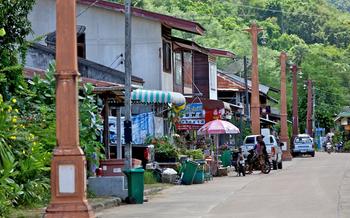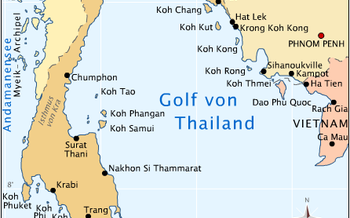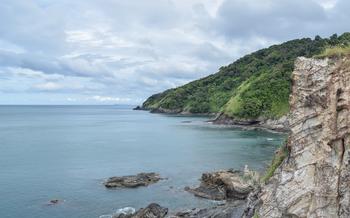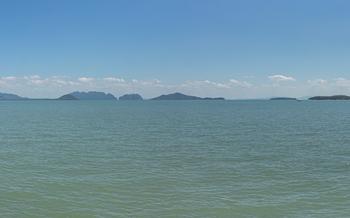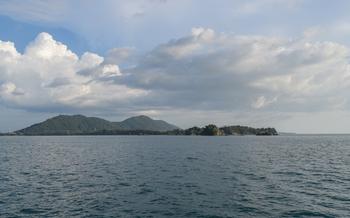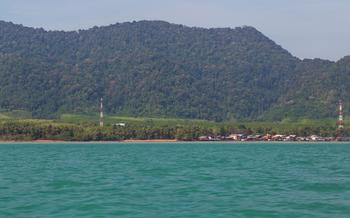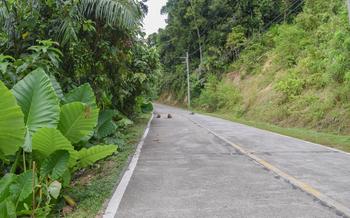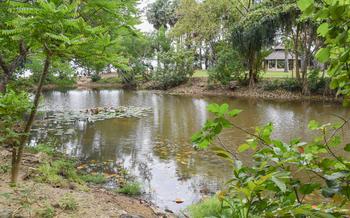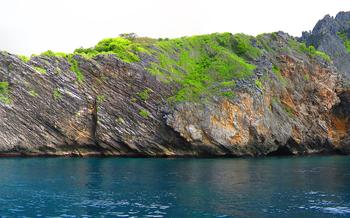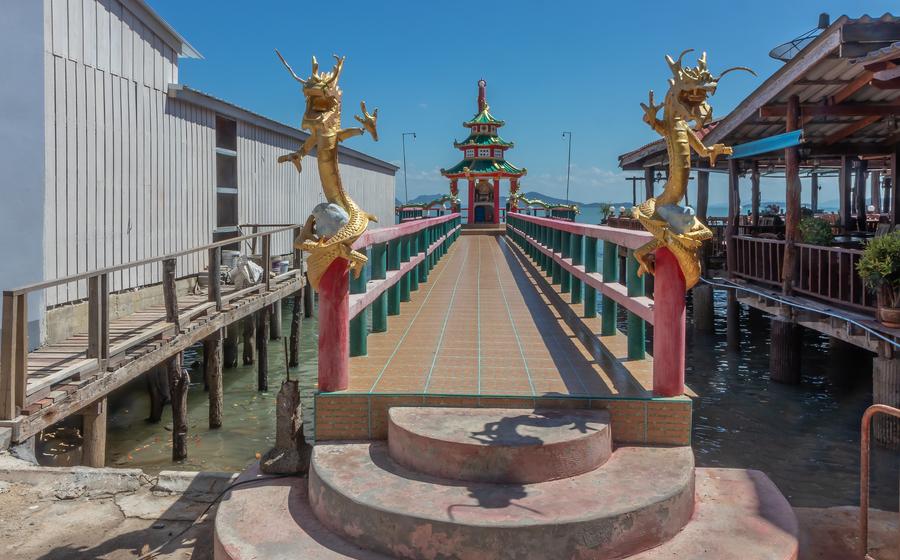
Ko Lanta Yai's east coast mangroves
- Ko Lanta Yai's East Coast Mangroves: A Natural Paradise
- Mangrove Ecosystem: The Foundation of Life
- Exploring the Mangroves by Kayak: A Serene Journey through Nature's Labyrinth
- Hiking Through the Mangroves: A Journey into Nature
- Birdwatching in the Mangroves: A Symphony of Nature
- Mangrove Photography: Capturing the Essence of Nature
- Learning from the Locals: Traditional Knowledge and Practices
- Mangrove Cuisine: A Taste of the Mangroves
- Mangrove Art and Crafts: Expressing the Essence of the Mangroves
- Mangrove Festivals and Events: Celebrating the Mangroves
- Mangrove Research and Education: Unlocking the Secrets of the Mangroves
- Insider Tip: Experience the Mangroves at Sunrise or Sunset
Ko Lanta Yai's East Coast Mangroves: A Natural Paradise
Ko Lanta Yai's east coast mangroves are a breathtaking natural paradise that offers a unique blend of scientific, historical, cultural, and practical experiences. These mangroves are home to a diverse array of flora and fauna, including over 100 species of mangrove trees, a variety of bird species, and a rich array of marine life.
Scientifically, the mangroves serve as a vital ecosystem, providing habitat and food for numerous species. Conservation efforts are underway to protect these fragile ecosystems, ensuring their long-term survival.
Historically, the mangroves have played a significant role in traditional fishing practices, providing a rich source of food and income for local communities. The mangroves have also served as a natural barrier, protecting the coastline from erosion and storms.
Culturally, the mangroves are deeply intertwined with the lives of local communities. The mangroves provide a source of livelihood, as well as materials for building, crafting, and cooking. The mangroves also hold cultural and spiritual significance, serving as a sacred place for many local communities.
Practically, the mangroves offer a variety of experiences for visitors. The best time to visit is during the dry season (November to April), when the weather is pleasant, and the waters are calm. Accessibility is relatively easy, with boat tours and kayak rentals available from local operators. Guided tours are also available, providing visitors with insights into the unique ecosystem and the local culture.
Mangrove Ecosystem: The Foundation of Life
Scientific Insights: Mangroves form the foundation of a complex and diverse ecosystem. These salt-tolerant plants have adapted to thrive in the harsh conditions of intertidal zones, creating a unique habitat for a wide range of species. Their intricate root systems provide a nursery for fish and invertebrates, while their leaves and branches offer nesting sites for birds and other wildlife. Mangroves also act as a natural filter, removing pollutants from the water and helping to maintain water quality.
Historical Significance: Mangroves have played a vital role in coastal protection throughout history. Their dense root systems help to stabilize shorelines, preventing erosion and protecting coastal communities from storms and tsunamis. Additionally, mangroves act as a natural carbon sink, absorbing and storing carbon dioxide from the atmosphere, contributing to climate change mitigation.
Cultural Importance: Mangroves hold deep cultural significance for coastal communities worldwide. In many cultures, mangroves are revered as sacred places, believed to be the abode of spirits or deities. Traditional fishing and gathering practices in mangrove forests have been passed down through generations, providing a sustainable livelihood for local communities.
Practical Relevance: Mangroves offer a wealth of opportunities for education and research. Scientists study these ecosystems to understand their ecological functions, biodiversity, and conservation needs. Mangrove forests also serve as outdoor classrooms, where students can learn about the importance of these ecosystems and the threats they face.
Exploring the Mangroves by Kayak: A Serene Journey through Nature's Labyrinth
Kayaking through the mangroves of Ko Lanta Yai offers a unique opportunity to immerse oneself in the tranquil beauty of this natural paradise. Glide along the winding waterways, surrounded by lush mangrove forests, and discover a world teeming with life.
Scientific Explorations: - Observe the diverse marine life that calls the mangroves home, including colorful fish, playful dolphins, and majestic sea turtles. - Spot a variety of bird species that inhabit the mangroves, from kingfishers and egrets to migratory birds that find refuge in these coastal ecosystems.
Historical Discoveries: - Learn about the ancient trading routes that once traversed these waterways, connecting Ko Lanta Yai to neighboring islands and mainland Thailand. - Explore hidden caves and rock formations that may have served as shelters for ancient seafarers and fishermen.
Cultural Encounters: - Experience traditional fishing techniques still practiced by local communities, using bamboo traps and nets to catch a variety of fish and shellfish. - Engage with the friendly locals who live in harmony with the mangroves, learning about their way of life and their deep connection to this unique ecosystem.
Practical Tips: - Rent a kayak from local operators who can provide guidance on the best routes and safety measures. - Choose a calm day with clear weather for optimal kayaking conditions. - Bring along a camera to capture the stunning scenery and wildlife encounters. - Be mindful of the tides and currents to ensure a safe and enjoyable kayaking experience.
Hiking Through the Mangroves: A Journey into Nature
Scientific:
Mangroves are home to a diverse range of flora and fauna, including plants that have adapted to the unique conditions of the mangrove environment. These adaptations include specialized root systems that help them anchor in the soft, muddy soil and salt-tolerant leaves that allow them to thrive in the saline environment. The mangroves also provide a habitat for a variety of animals, including birds, reptiles, and amphibians.
Historical:
The mangroves of Ko Lanta Yai have a rich history, dating back to the days when indigenous tribes inhabited the island. These tribes relied on the mangroves for food, shelter, and medicine. The mangroves also played a role in the island's maritime history, as they provided a safe haven for ships traveling the Andaman Sea.
Cultural:
The mangroves hold a special place in the culture of the local communities. The people of Ko Lanta Yai have a deep respect for the mangroves and believe that they are sacred. They have traditionally used the mangroves for a variety of purposes, including fishing, collecting firewood, and building materials.
Practical:
There are a number of hiking trails that wind through the mangroves of Ko Lanta Yai. These trails offer visitors a chance to explore the unique ecosystem of the mangroves and see the diverse plant and animal life that it supports. The trails vary in difficulty, so there is something for everyone, from beginner hikers to experienced trekkers.
Tips for Hiking in the Mangroves:
- Wear comfortable shoes that you don't mind getting wet.
- Bring plenty of water and snacks.
- Be aware of the tides. The mangroves are flooded at high tide, so it is important to plan your hike accordingly.
- Be respectful of the wildlife. The mangroves are home to a variety of animals, so please do not disturb them.
- Enjoy the experience! Hiking in the mangroves is a great way to connect with nature and learn about the unique ecosystem of these coastal forests.
Birdwatching in the Mangroves: A Symphony of Nature
The mangroves of Ko Lanta Yai are a haven for birdlife, providing a diverse and vibrant habitat for a wide variety of species. From the majestic Brahminy kite soaring overhead to the tiny sunbirds flitting among the mangrove flowers, there is a symphony of bird calls and colors to be discovered.
Scientifically, the mangrove ecosystem supports a rich array of bird species due to its unique combination of habitats, including mudflats, tidal channels, and mangrove forests. These diverse habitats provide nesting, feeding, and roosting sites for both resident and migratory birds. Ornithologists have identified over 100 bird species in the mangroves of Ko Lanta Yai, including many that are rare or endangered.
Historically, the mangroves have played a vital role in the migration patterns of birds. The mudflats and tidal channels provide a crucial stopover point for migratory shorebirds, such as sandpipers, plovers, and curlews, on their long journeys between breeding and wintering grounds.
Culturally, the mangroves hold a special place in the hearts of the local people. Birds are often seen as symbols of good luck and fortune, and many local legends and folklores revolve around them. Birdwatching is also a popular pastime among the locals, who enjoy spending their free time observing the colorful and diverse birdlife in the mangroves.
Practically, there are several ways to enjoy birdwatching in the mangroves of Ko Lanta Yai. Visitors can explore the mangroves by kayak or boat, which allows them to get close to the birds without disturbing them. Guided birdwatching tours are also available, led by experienced local guides who can help visitors identify and learn about the different bird species.
Whether you are an experienced birdwatcher or a casual nature enthusiast, the mangroves of Ko Lanta Yai offer a unique and rewarding birdwatching experience. With its rich diversity of birdlife and stunning natural scenery, it is a true paradise for bird lovers.
Mangrove Photography: Capturing the Essence of Nature
Mangroves present a photographer's paradise, offering a rich tapestry of colors, textures, and compositions. Whether you're a seasoned professional or an enthusiastic amateur, the mangroves of Ko Lanta Yai provide ample opportunities to capture the essence of nature through the lens of your camera.
Scientific: Mangrove photography is not just about aesthetics but also about documenting the intricate biodiversity and ecological processes that define these unique ecosystems. By capturing close-ups of intricate root systems, vibrant flowers, and diverse wildlife, you can contribute to the scientific understanding of mangrove ecosystems and raise awareness about their conservation.
Historical: Historical photographs of mangroves provide a valuable glimpse into the past, showcasing the evolution of these landscapes and the traditional practices of local communities. Your photographs can become part of this historical record, preserving the legacy of these vital ecosystems for future generations.
Cultural: The mangroves hold deep cultural significance for the people of Ko Lanta Yai. By capturing images of local people interacting with the mangroves, using traditional fishing techniques, or harvesting mangrove products, you can showcase the cultural heritage and sustainable practices associated with these ecosystems.
Practical: To capture stunning mangrove photographs, consider the following tips:
- Use the right equipment: A wide-angle lens is ideal for capturing the vastness of the mangroves, while a macro lens will allow you to focus on the intricate details of flora and fauna.
- Experiment with different lighting conditions: The golden light of sunrise and sunset can create a magical atmosphere in your photographs. Use a tripod to stabilize your camera and capture long exposure shots that capture the movement of water and clouds.
- Be patient and observant: Mangrove ecosystems are teeming with life, but many creatures are shy and easily spooked. Take your time, observe the mangroves quietly, and wait for the perfect moment to capture your shot.
Learning from the Locals: Traditional Knowledge and Practices
Ko Lanta's mangroves are not just a natural wonder; they are also an integral part of the local culture. For generations, the people of Ko Lanta have relied on the mangroves for their livelihoods and sustenance. They have developed a deep understanding of the mangrove ecosystem and its unique resources.
Scientific: Indigenous knowledge about mangrove ecology and sustainable use is a valuable asset for scientists and conservationists. Local communities have a wealth of information about mangrove species, their interactions with other organisms, and the best ways to manage and protect these ecosystems. This knowledge can help researchers develop more effective conservation strategies and management plans.
Historical: Traditional mangrove-based livelihoods and their evolution reflect the close relationship between the local people and their environment. Fishing, shellfish collection, and mangrove honey production are just a few of the ways that the people of Ko Lanta have traditionally utilized the mangroves. These practices have been passed down through generations, shaping the cultural identity and heritage of the island.
Cultural: Local beliefs, rituals, and ceremonies related to mangroves demonstrate the deep spiritual and cultural significance of these ecosystems. The mangroves are seen as sacred places, home to spirits and deities. Traditional ceremonies and rituals are held to honor these spirits and to ask for their blessings for a bountiful harvest and protection from storms.
Practical: Opportunities to interact with locals, learn traditional skills, and support community-based tourism abound in Ko Lanta. Visitors can join local fishermen on their daily excursions, learn how to collect shellfish or produce mangrove honey, or participate in mangrove planting and conservation activities. These experiences offer a unique glimpse into the traditional way of life in the mangroves and help support local communities.
Mangrove Cuisine: A Taste of the Mangroves
The mangroves of Ko Lanta Yai offer a unique culinary experience, showcasing the diverse flavors and ingredients derived from these rich ecosystems. Local communities have developed a range of traditional dishes and delicacies that utilize mangrove plants, creating a cuisine that is both delicious and sustainable.
Scientifically speaking, mangrove plants possess a variety of nutritional and medicinal properties. Their leaves, fruits, and roots are rich in vitamins, minerals, and antioxidants, contributing to a healthy and balanced diet. The use of mangrove plants in cuisine not only provides essential nutrients but also supports the conservation of these vital ecosystems.
Historically, mangrove cuisine has evolved over generations, influenced by the unique environment and cultural practices of the local communities. Traditional recipes have been passed down through families, preserving the culinary heritage of the region. Mangrove-based dishes are often prepared using simple techniques, highlighting the natural flavors and textures of the ingredients.
Culturally, mangrove cuisine holds a special place in the hearts of the local people. It represents their connection to the mangroves and their way of life. Mangrove plants are not only a source of food but also play a significant role in local traditions, rituals, and ceremonies. The preparation and sharing of mangrove-based dishes strengthen community bonds and celebrate the bounty of the mangroves.
Practically speaking, visitors to Ko Lanta Yai can savor the delights of mangrove cuisine at local restaurants and markets. Freshly caught seafood, such as crabs, shrimp, and fish, is often cooked using mangrove leaves or spices, imparting a unique flavor to the dishes. Local delicacies include mangrove honey, a sweet and aromatic treat produced by bees that feed on mangrove nectar, and mangrove-infused desserts, which showcase the versatility of these remarkable plants.
Mangrove Art and Crafts: Expressing the Essence of the Mangroves
The mangroves of Ko Lanta Yai have inspired a rich tradition of arts and crafts. Local artisans create beautiful souvenirs featuring mangrove-inspired motifs and designs. These crafts are not only a source of income for the local community but also a way to express their connection to the mangroves.
Scientific: Mangrove-inspired crafts often depict the unique flora and fauna of the mangroves, such as fiddler crabs, mudskippers, and mangrove trees. These crafts can be a valuable tool for educating visitors about the importance of mangrove ecosystems.
Historical: Mangrove-based crafts have a long history in Ko Lanta Yai. In the past, local artisans used mangrove leaves and wood to make baskets, mats, and other household items. Today, these traditional crafts are still practiced, but artisans also use a variety of other materials, such as recycled glass and metal, to create their works of art.
Cultural: Mangrove crafts are an important part of the local culture. They are often used to decorate homes and temples and are also given as gifts on special occasions. Mangrove-inspired motifs can also be found in local dance and music.
Practical: Visitors to Ko Lanta Yai can find mangrove-inspired arts and crafts for sale at local markets and galleries. These crafts make unique souvenirs and gifts that will remind you of your time spent in the mangroves.
Mangrove Festivals and Events: Celebrating the Mangroves
The vibrant culture of Ko Lanta Yai comes alive during mangrove festivals and events, paying homage to these remarkable ecosystems and their significance to the local community. These celebrations are a kaleidoscope of colors, music, and traditions, offering visitors a glimpse into the deep-rooted connection between the people of Lanta and their natural surroundings.
One of the most prominent events is the annual Mangrove Festival, a grand showcase of mangrove conservation and appreciation. Held every year in September, the festival draws participants from across the region to celebrate the unique biodiversity of the mangroves and raise awareness about their importance.
During the festival, visitors can immerse themselves in a myriad of activities, including educational workshops, guided mangrove tours, art exhibitions, and traditional performances. Local artisans display their mangrove-inspired crafts, showcasing the intricate skills and techniques passed down through generations. The air fills with the rhythm of traditional music and dance, as performers pay tribute to the mangroves through their art.
These festivals are not merely celebrations; they serve as a platform for dialogue and collaboration between scientists, conservationists, and local communities. They provide a space for sharing knowledge, experiences, and best practices, fostering a sense of collective responsibility for protecting these precious ecosystems.
Participating in a mangrove festival is an unforgettable experience, offering visitors a chance to connect with the local culture, celebrate the beauty of the mangroves, and contribute to their conservation. Whether you're a nature enthusiast, a photographer, or simply someone who appreciates the harmony between humans and the environment, these events offer a unique and immersive way to experience the mangroves of Ko Lanta Yai.
Mangrove Research and Education: Unlocking the Secrets of the Mangroves
Ko Lanta Yai's east coast mangroves have been a focal point for scientific research and education for decades, owing to their ecological significance and the need for their conservation. Researchers from various institutions have conducted extensive studies on the mangroves' biodiversity, ecological processes, and the impact of human activities on these fragile ecosystems. The findings of these studies have contributed to a better understanding of mangrove ecology and have informed conservation efforts worldwide.
In recent years, there has been a growing emphasis on mangrove education and outreach programs to raise awareness of the importance of these ecosystems and to foster a sense of stewardship among local communities and visitors. Universities and research institutions offer courses, workshops, and seminars on mangrove ecology, conservation, and sustainable use. Educational programs for school children and the general public are also conducted to promote an understanding of the mangroves' role in coastal protection, carbon sequestration, and biodiversity conservation.
Insider Tip: Experience the Mangroves at Sunrise or Sunset
The mangroves of Ko Lanta Yai offer a unique and enchanting experience during sunrise and sunset. As the sun rises, the sky transforms into a canvas of warm hues, casting a golden glow across the tranquil waters and mangrove forests. The air is still and serene, allowing you to fully immerse yourself in the beauty of nature. This magical light is perfect for capturing breathtaking photographs of the mangroves, with the silhouettes of trees and the reflections of the water creating a picturesque scene.
At sunset, the mangroves take on a different charm. As the sun dips below the horizon, the sky bursts into a vibrant array of colors, painting the mangroves in shades of pink, orange, and purple. The mangroves come alive with the sounds of nocturnal creatures emerging from their hiding places, creating a symphony of nature. This is an ideal time to witness the mangroves' unique biodiversity, as various species of birds, insects, and reptiles become active in the fading light.
Whether you choose to experience the mangroves at sunrise or sunset, it's an unforgettable moment that will leave you in awe of nature's beauty. So, make sure to set your alarm early or stay out late to witness this magical spectacle—a true highlight of your visit to Ko Lanta Yai.

